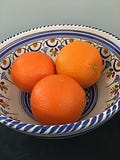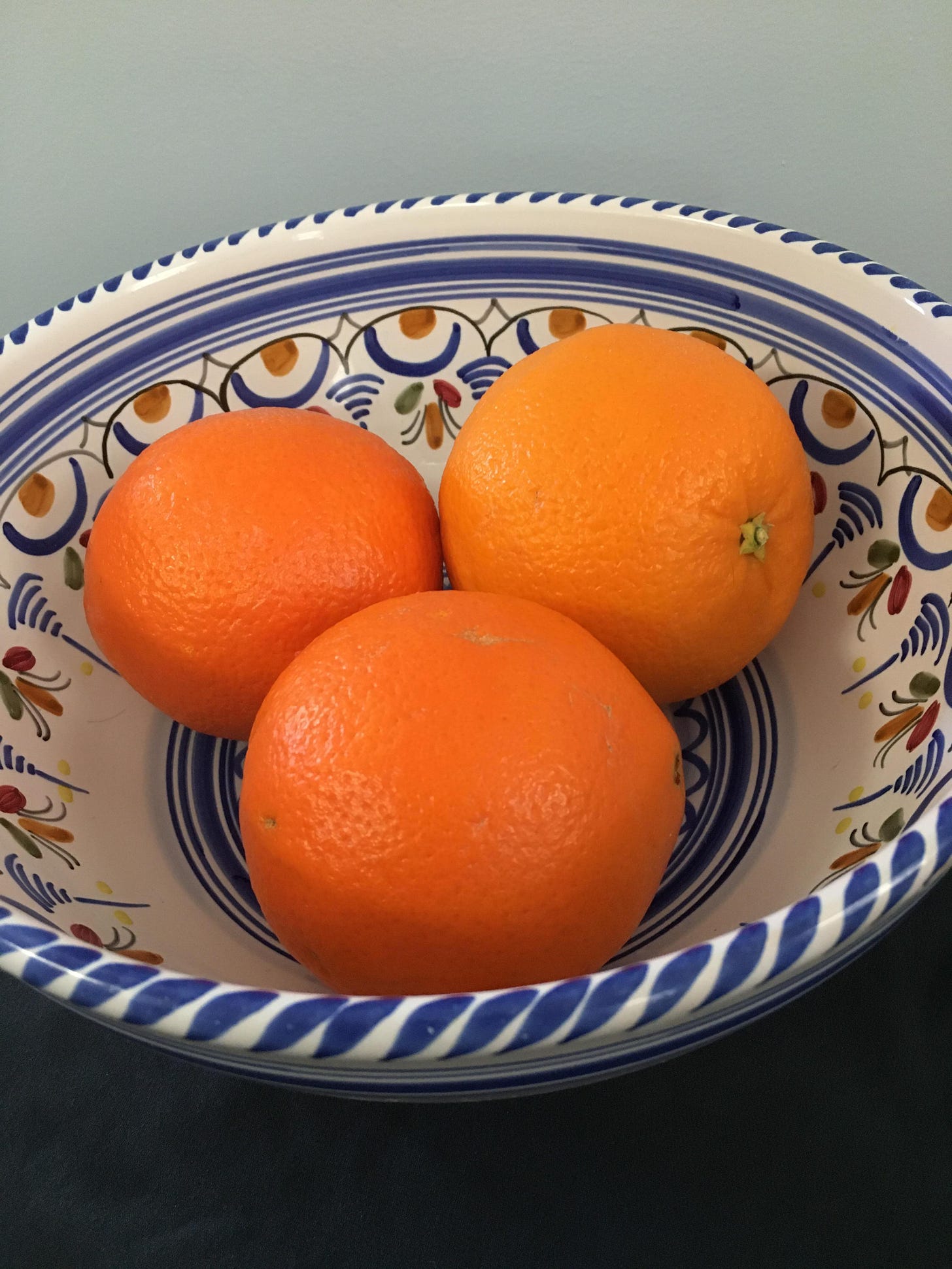Proteins in human milk function as carriers for vitamins.
The water-soluble vitamins are: 1 C and 8 B’s
Water-soluble vitamins in human milk are readily influenced by maternal diet. The breast does not make any of these vitamins. Instead they come from the maternal plasma via the mother’s diet.
Vitamin C
Vitamin C, also called ascorbic acid, is found in a wide variety of fruit and vegetables. Good sources include citrus fruits (like oranges and orange juice), peppers, strawberries, broccoli, Brussels sprouts and potatoes. [“Brussels sprouts" is not a typo as they are named after the Belgium capital city!]
Vitamin C levels in human milk reflect maternal dietary intake. The good news is that vitamin C levels in milk are higher than in maternal plasma.
Vitamin C is an antioxidant. It is part of several enzyme and hormone systems, as well as intracellular chemical reactions. It is essential to collagen synthesis.
A deficiency of vitamin C causes bleeding gums and scurvy.
The eight B vitamins
B1 (thiamin). A deficiency of vitamin B1 causes beriberi.
B2 (riboflavin).
B3 (niacin). A deficiency of vitamin B3 causes pellagra.
B5 (pantothenic acid)
B6 (pyridoxine). Mega doses of vitamin B6 can decrease prolactin levels and therefore affect lactation.
B7 (biotin)
B9 (folate or folic acid). A deficiency of prenatal folic acid can result in neural tube defects in infants.
B12 (cyanocobalamin)
Vitamin B12
Some more about vitamin B12 because I bet there will be a question on this on the test.
A woman eating a vegan diet, a diet without meat products, could produce milk that is vitamin B12 deficient. Supplementation with vitamin B12 may be indicated. Vitamin B12 deficiency presents as failure to thrive, lethargy, hypotonia, developmental delay, neurologic defects and megaloblastic anemia.
Also, bariatric surgery may cause vitamin B12 deficiency. In a case report, Grange et al described a 10-month old who presented with failure to thrive and megaloblastic anemia. The infant was found to have vitamin B12 deficiency. The mother had undergone a gastric bypass procedure for morbid obesity two years prior to her pregnancy with this child. She had subclinical vitamin B12 deficiency. (Reference 1)
Some top sources of B vitamins include meat (especially liver), seafood, poultry, eggs, dairy products, legumes, leafy greens, seeds and fortified foods like breakfast cereal and nutritional yeast.
Recognize this word: inositol
Inositol is a nutrient in the vitamin B complex. It is often referred to as vitamin B8, but it actually is not a vitamin. Inositol is present in high concentrations in human milk, including in colostrum (of course!). It is involved in circulation and fat and cholesterol metabolism and may play a role in brain development. Many infant formulas are supplemented with inositol.
Recognize this word: choline
Choline is an essential nutrient. It is neither a vitamin nor a mineral but is often grouped with the vitamin B complex due to its similarities. Choline is involved in liver function and is a major constituent of membranes in the brain and nervous tissue.
References
Grange DK, Finlay JL. Nutritional vitamin B12 deficiency in a breastfed infant following maternal gastric bypass. Pediatric Hematology and Oncology. 1994;11(3):311-318.
Tema 13. Proteínas Parte 5: Vitaminas Hidrosolubles
Las proteínas de la leche humana funcionan como portadoras de vitaminas.
Las vitaminas hidrosolubles son: Las 8 B y 1 C.
Las vitaminas hidrosolubles de la leche humana son fácilmente influenciadas por la dieta materna. El pecho no produce ninguna de estas vitaminas, por lo que proceden del plasma materno a través de la dieta de la madre.
Vitamina C
La vitamina C, también llamada ácido ascórbico, se encuentra en una gran variedad de frutas y verduras. Entre las buenas fuentes se encuentran los cítricos (como las naranjas y el zumo de naranja), los pimientos, las fresas, el brócoli, las coles de Bruselas y las patatas.
Los niveles de vitamina C en la leche humana reflejan la ingesta dietética de la madre. La buena noticia es que los niveles de vitamina C en la leche son más altos que en el plasma materno.
La vitamina C es un antioxidante. Forma parte de varios sistemas enzimáticos y hormonales, así como de reacciones químicas intracelulares. Es esencial para la síntesis de colágeno.
Una deficiencia de vitamina C provoca sangrado de las encías y escorbuto.
Vitaminas B
Las ocho vitaminas B son:
B1 (tiamina). La carencia de vitamina B1 provoca el beriberi.
B2 (riboflavina).
B3 (niacina). La carencia de vitamina B3 provoca pelagra.
B5 (ácido pantoténico)
B6 (piridoxina) - Dosis elevadas de vitamina B6 pueden disminuir los niveles de prolactina y, por tanto, afectar a la lactancia.
B7 (biotina)
Folato o ácido fólico (B9) - Una deficiencia de ácido fólico prenatal puede provocar defectos del tubo neural en los bebés.
B12 (cianocobalamina)
Vitamin B12
Una mujer que siga una dieta vegana, es decir, una dieta sin carne ni productos lácteos, podría producir una leche deficiente en vitamina B12. Es posible que le indiquen un suplemento de vitamina B12. La deficiencia de vitamina B12 se presenta como retraso de crecimiento, letargia, hipotonía, retraso en el desarrollo, defectos neurológicos y anemia megaloblástica.
La cirugía bariátrica puede causar deficiencia de vitamina B12. Grange et al. describieron, en un informe de caso, un niño de 10 meses que presentaba un retraso de crecimiento y anemia megaloblástica. Se descubrió que el bebé tenía una deficiencia de vitamina B12. La madre se había sometido a un procedimiento de bypass gástrico por obesidad mórbida dos años antes del embarazo de este niño. Tenía una deficiencia subclínica de vitamina B12.
Apréndete esta palabra: inositol.
El inositol es un nutriente del complejo vitamínico B. A menudo se le denomina vitamina B8, pero en realidad no es una vitamina. El inositol está presente en altas concentraciones en la leche humana, incluso en el calostro (¡por supuesto!). Interviene en la circulación y en el metabolismo de las grasas y el colesterol y puede desempeñar un papel en el desarrollo del cerebro. Muchas fórmulas infantiles tienen un suplemento de inositol.
Apréndete esta palabra: colina.
La colina es un nutriente esencial. No es una vitamina ni un mineral, pero a menudo se agrupa con el complejo vitamínico B debido a sus similitudes. La colina interviene en el funcionamiento del hígado y es un componente importante de las membranas del cerebro y del tejido nervioso.
Referencias
Grange DK, Finlay JL. Nutritional vitamin B12 deficiency in a breastfed infant following maternal gastric bypass [Deficiencia nutricional de vitamina B12 en un bebé amamantado tras un bypass gástrico materno]. Pediatric Hematology and
Oncology. 1994;11(3):311-318.




